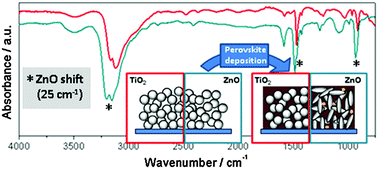J. Idígoras, A. Todinova, J. R. Sánchez-Valencia, A. Barranco, A. Borrás, J. A. Anta
Physical Chemistry Chemical Physics, 18 (2016) 13583-13590
doi: 10.1039/C6CP01265E
The interaction of hybrid organic–inorganic halide perovskite and selective contacts is crucial to get efficient, stable and hysteresis-free perovskite-based solar cells. In this report, we analyze the vibrational properties of methylammonium lead halide perovskites deposited on different substrates by infrared absorption (IR) measurements (4000–500 cm−1). The materials employed as substrates are not only characterized by different chemical natures (TiO2, ZnO and Al2O3), but also by different morphologies. For all of them, we have investigated the influence of these substrate properties on perovskite formation and its degradation by humidity. The effect of selective-hole contact (Spiro-OmeTad and P3HT) layers on the degradation rate by moisture has also been studied. Our IR results reveal the existence of a strong interaction between perovskite and all ZnO materials considered, evidenced by a shift of the peaks related to the N–H vibrational modes. The interaction even induces a morphological change in ZnO nanoparticles after perovskite deposition, pointing to an acid–base reaction that takes place through the NH3+ groups of the methylammonium cation. Our IR and X-ray diffraction results also indicate that this specific interaction favors perovskite decomposition and PbI2 formation for ZnO/perovskite films subjected to humid conditions. Although no interaction is observed for TiO2, Al2O3, and the hole selective contact, the morphology and chemical nature of both contacts appear to play an important role in the rate of degradation upon exposure to moisture.


